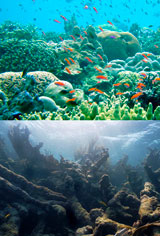Coral Reefs in Danger

The director of the census bureau in charge of marine species, called the Global Marine Species Assessment, has issued a warning about the deterioration of earth’s coral reefs. It was stated that perhaps within 100 years we may see the total collapse of all the coral reefs around the country and the world. Future generations will be severely affected if we don’t start taking the steps to protect these natural wonders, which provide enormous benefits to humanity.
As many as 1 billion people could be affected, especially in Asia, where much of the population depends on the reefs for their livelihoods. So the major question on the table becomes: what’s causing the die-off of coral reefs around the world? A prime cause is global warming: as ocean water begins to rise in temperature, coral begins to die off, causing coral bleaching.
Wikipedia provides a handy definition of coral bleaching as “the whitening of corals due to stress-induced expulsion or death of symbiotic, algae-like protozoa, or due to the loss of pigmentation within the protozoa,” adding that “once the bleaching begins, it will continue even without continuing stress.”
If you were looking at the earth from outer space, you could see whole areas where coral is whitening and dying, largely because of global warming. Other causes include typhoons, hurricanes, coral-eating predators like the crown of thorns starfish, overfishing, pollution, coastal development, and even disease.
Many people really aren’t aware of the everyday benefits that the reefs provide; it’s one of those things that is otherwise taken for granted. For example, the outer edges of reefs receive the full force of breaking waves, protecting many shorelines from daily erosion damage. Various forms of hard coral are now being experimented with in the laboratory as possible solutions for bone replacement. Treatments for a number of diseases including cancer, AIDS, and arthritis have been developed from the tiny organisms and unique compounds that reside within the reefs. By one estimate, coral reefs provide ecosystem services and economic goods worth over $300 billion each year to millions of people around the world.
About 19% of all the coral reefs around the world are already gone, and an estimated 50% of those are in the Mediterranean Sea alone. Moreover, 15% of the remaining reefs could die within the next 20 years, and perhaps all of them within a century. This could of course be catastrophic for the biosphere, because the coral structure provides dwellings for sea creatures at the bottom of the food chain. The effects could essentially ripple through directly to the top of the chain, where we as humans sit. Common fish including snappers could be immediately affected, while a wide array of shellfish could also die off as the reefs themselves begin to die.
It should also be noted that the fisheries of the world currently employ an estimated 30+ million people. Indirectly, an estimated 162 million people currently rely on the fishing industry. So, we sitting at the top of the food chain should take pay closer attention to what’s happening at the bottom . It’s not too late to start taking the necessary steps to help preserve these beautiful and valuable resources. It is clear, however, that something needs to be done—today.
Want to know how you can help?
The Nature Conservancy provides 10 effective ways to make an impact. Visit their website at http://www.nature.org/joinanddonate/rescuereef/explore/help.html to learn more.





